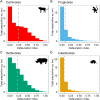Intact but empty forests? Patterns of hunting-induced mammal defaunation in the tropics
- PMID: 31086365
- PMCID: PMC6516652
- DOI: 10.1371/journal.pbio.3000247
Intact but empty forests? Patterns of hunting-induced mammal defaunation in the tropics
Abstract
Tropical forests are increasingly degraded by industrial logging, urbanization, agriculture, and infrastructure, with only 20% of the remaining area considered intact. However, this figure does not include other, more cryptic but pervasive forms of degradation, such as overhunting. Here, we quantified and mapped the spatial patterns of mammal defaunation in the tropics using a database of 3,281 mammal abundance declines from local hunting studies. We simultaneously accounted for population abundance declines and the probability of local extirpation of a population as a function of several predictors related to human accessibility to remote areas and species' vulnerability to hunting. We estimated an average abundance decline of 13% across all tropical mammal species, with medium-sized species being reduced by >27% and large mammals by >40%. Mammal populations are predicted to be partially defaunated (i.e., declines of 10%-100%) in ca. 50% of the pantropical forest area (14 million km2), with large declines (>70%) in West Africa. According to our projections, 52% of the intact forests (IFs) and 62% of the wilderness areas (WAs) are partially devoid of large mammals, and hunting may affect mammal populations in 20% of protected areas (PAs) in the tropics, particularly in West and Central Africa and Southeast Asia. The pervasive effects of overhunting on tropical mammal populations may have profound ramifications for ecosystem functioning and the livelihoods of wild-meat-dependent communities, and underscore that forest coverage alone is not necessarily indicative of ecosystem intactness. We call for a systematic consideration of hunting effects in (large-scale) biodiversity assessments for more representative estimates of human-induced biodiversity loss.
Conflict of interest statement
The authors have declared that no competing interests exist.
Figures




References
-
- Bennett EL. Is there a link between wild meat and food security? Conservation Biology. 2002;16(3):590–2.
-
- Peres CA. Effects of subsistence hunting on vertebrate community structure in Amazonian forests. Conservation Biology. 2000;14(1):240–53.
MeSH terms
LinkOut - more resources
Full Text Sources
Miscellaneous

